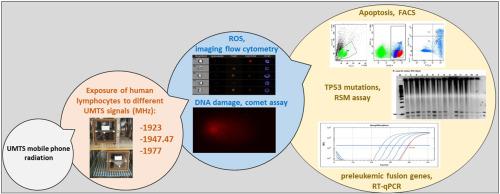Environmental Pollution ( IF 7.6 ) Pub Date : 2020-09-11 , DOI: 10.1016/j.envpol.2020.115632 Sachin Gulati , Pavol Kosik , Matus Durdik , Milan Skorvaga , Lukas Jakl , Eva Markova , Igor Belyaev

|
Different scientific reports suggested link between exposure to radiofrequency radiation (RF) from mobile communications and induction of reactive oxygen species (ROS) and DNA damage while other studies have not found such a link. However, the available studies are not directly comparable because they were performed at different parameters of exposure, including carrier frequency of RF signal, which was shown to be a critical for appearance of the RF effects. For the first time, we comparatively analyzed genotoxic effects of UMTS signals at different frequency channels used by 3G mobile phones (1923, 1947.47, and 1977 MHz). Genotoxicity was examined in human lymphocytes exposed to RF for 1 h and 3 h using complimentary endpoints such as induction of ROS by imaging flow cytometry, DNA damage by alkaline comet assay, mutations in TP53 gene by RSM assay, preleukemic fusion gens (PFG) by RT-qPCR, and apoptosis by flow cytometry. No effects of RF exposure on ROS, apoptosis, PFG, and mutations in TP53 gene were revealed regardless the UMTS frequency. On the other hand, we found relatively small but statistically significant induction of DNA damage in dependence on UMTS frequency channel with maximal effect at 1977.0 MHz. Our data support a notion that each specific signal used in mobile communication should be tested in specially designed experiments to rule out that prolonged exposure to RF from mobile communication would induce genotoxic effects and affect the health of human population.
中文翻译:

不同手机UMTS信号对人淋巴细胞DNA,细胞凋亡和氧化应激的影响
不同的科学报告表明,移动通信暴露于射频辐射(RF)与活性氧(ROS)和DNA损伤的诱导之间存在联系,而其他研究尚未发现这种联系。但是,可用的研究不是直接可比的,因为它们是在不同的曝光参数下进行的,包括RF信号的载波频率,这对于RF效应的出现至关重要。首次,我们比较分析了UMTS信号在3G手机使用的不同频道(1923、1947.47和1977 MHz)上的遗传毒性作用。使用互补终点(例如通过成像流式细胞术诱导ROS,碱性彗星试验对DNA的损伤,通过RSM分析检测TP53基因突变,通过RT-qPCR检测白血病前融合基因(PFG)以及通过流式细胞仪检测凋亡。无论UMTS频率如何,都没有发现RF暴露对ROS,凋亡,PFG和TP53基因突变的影响。另一方面,我们发现依赖于UMTS频道的DNA损伤相对较小,但在统计学上具有显着意义,在1977.0 MHz处具有最大作用。我们的数据支持一种观念,即应在专门设计的实验中测试移动通信中使用的每个特定信号,以排除移动通信长时间暴露于RF会引起遗传毒性作用并影响人类健康。不管UMTS频率如何,都揭示了TP53基因的突变。另一方面,我们发现依赖于UMTS频道的DNA损伤相对较小,但在统计学上具有显着意义,在1977.0 MHz处具有最大作用。我们的数据支持一种观念,即应在专门设计的实验中测试移动通信中使用的每个特定信号,以排除移动通信长时间暴露于RF会引起遗传毒性作用并影响人类健康。不管UMTS频率如何,都揭示了TP53基因的突变。另一方面,我们发现依赖于UMTS频道的DNA损伤相对较小,但在统计学上具有显着意义,在1977.0 MHz处具有最大作用。我们的数据支持一种观念,即应在专门设计的实验中测试移动通信中使用的每个特定信号,以排除移动通信长时间暴露于RF会引起遗传毒性作用并影响人类健康。











































 京公网安备 11010802027423号
京公网安备 11010802027423号